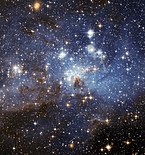| Star formation |
|---|
 |
| Object classes |
| Theoretical concepts |
A molecular cloud, sometimes called a stellar nursery (if star formation is occurring within), is a type of interstellar cloud, the density and size of which permit absorption nebulae, the formation of molecules (most commonly molecular hydrogen, H2), and the formation of H II regions. This is in contrast to other areas of the interstellar medium that contain predominantly ionized gas.
Molecular hydrogen is difficult to detect by infrared and radio observations, so the molecule most often used to determine the presence of H2 is carbon monoxide (CO). The ratio between CO luminosity and H2 mass is thought to be constant, although there are reasons to doubt this assumption in observations of some other galaxies.[1]
Within molecular clouds are regions with higher density, where much dust and many gas cores reside, called clumps. These clumps are the beginning of star formation if gravitational forces are sufficient to cause the dust and gas to collapse.[2]
- ^ Craig Kulesa. "Overview: Molecular Astrophysics and Star Formation". Research Projects. Retrieved September 7, 2005.
- ^ Astronomy (PDF). Rice University. 2016. p. 761. ISBN 978-1938168284 – via Open Stax.